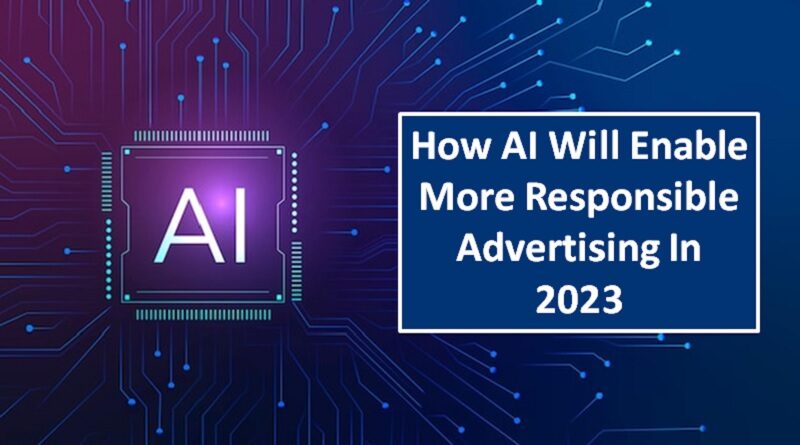How AI Will Enable More Responsible Advertising In 2023
Consumers demand that a brand’s values match their own. This expectation is catapulting ethical advertising and, consequently, brand fit to the forefront of the business debate. As a result, advertisers and publishers are concentrating more on finding effective ways to realise the objective of strategic, ethical advertising. But as digital media has grown, it has becoming harder to control what kind of material adverts appear next to and where they do. Chief Science Officer and Co-Founder of Cognitiv Aaron Andalman talks about how AI will benefit businesses by allowing them to concentrate on doing more ethical advertising.
Ad placements next to values or material that do not always align with those of the advertiser are an unwanted side effect of programmatic advertising, which has also been plagued with fraud and misinformation. These kinds of placements can be harmful to a company’s reputation by leading consumers to believe that the brand endorses messaging that it does not, or by unintentionally harming consumers by magnifying false or negative information.
Because programmatic advertising necessitates making millions of placement decisions every second, avoiding these kinds of ad placement has proven difficult. While it has been possible for companies to exclude entire domains or publishers that frequently fail to adhere to their principles (using crude tools like exclusion lists), this system has proven ineffective for matching ad placements with brand values. Fortunately, the coming year appears to be positive as new technologies present chances for the sector to make more ethical and deliberate ad placement a reality.
What Constitutes Reputable Advertising? Why Is It Difficult?
Making sure your marketing and advertising strategy has a good impact on society, the environment, and other factors is the foundation of truly responsible advertising. This is made possible by using ethical advertising strategies that support a brand’s values and objectives while diverting spending from offensive or harmful content. Enabling a more specific, accurate method of evaluating the value and intent of a specific web page has been one of the most difficult tasks facing the responsible advertising movement.
There are too many web pages for humans to manually read and assess each one, even though it is simple for a human to determine whether a webpage adheres to a brand’s values. Combining classical machine learning with keyword analysis is a frequent strategy for solving this problem, but the results of these approaches have been mixed. More than just keywords, block lists, and filters are needed to choose an appropriate location for an advertisement. According to research, major news websites mistakenly flag more than half (57%) of neutral or positive content as unsuitable for advertising.
a new window is opened. This is largely because extensive exclusion lists prohibit 2000–3000 terms that are designated as “unsafe” without taking the context of their use into account. The opposite is also accurate when assessing image-based information, such as memes, which may contain language that appears innocent at first look but turns objectionable when read in light of the context provided by the accompanying visuals.
The limits of the current solutions are severe, even while they have helped maintain brand safety by prohibiting advertisements for brands from being displayed alongside material that could harm their reputation. This includes diminishing relevant programmatic ad inventory and publisher revenue, restricting the campaign reach, and making it more difficult for advertisers to properly optimise their media strategy.
AI Advances Open the Door to New Solutions
New developments have given the technology a more human understanding of context, enabling it to align content to values more effectively. Earlier iterations of machine learning and natural language processing were constrained in their ability to answer complex questions about content, such as “does this content align to my brand’s values.”
These developments are supported by huge foundational language models in terms of technology. These models were trained using sizable text corpora that were downloaded from the internet. These massive artificial neural networks are then trained using these data sets, pushing the limits of what is currently possible with supercomputers. As a result, computer models are able to comprehend and produce text much better than any previous technology. Some scientists have controversially hypothesised that the models are sentient since they are so impressive.
a new window is opened! Although it may be a stretch, these models undoubtedly create totally new opportunities for the kinds of activities that computers can perform. It is challenging to apply these models to actual business issues, though.
Large language models are computationally taxing, and before they can be used for a given use case, they frequently need to be fine-tuned using particular data. Forward-thinking companies have been working hard over the past few years to create the training data sets, infrastructure, and business logic required to bring this technology to market, which will pick up speed in 2023. In 2023, as this AI technology becomes more widely accessible, advertisers will be better able to meet their individual contextual and appropriateness demands and more easily avoid items they do not want to be associated with, leading to a more responsible approach to advertising.
Advertisers will be able to avoid media buys on websites that are exclusive, include false information, or don’t correspond with their basic principles more successfully if they have a more nuanced and accurate understanding of the context in which ads are placed. The advertising industry will be able to choose media more carefully, strategically, and individually as fresh research and infrastructure investments bring this AI technology to market. Better contextual targeting technologies in particular will make it easier for programmatic advertisers to steer clear of websites that do not share their beliefs.
An industry-wide shift from brand safety (avoiding any risky content) toward brand suitability (i.e., how well a webpage fits within a brand’s set risk parameters) will be sparked by using AI to make smarter media buying and ad spend decisions. This shift will be invaluable in allowing brands to advertise more responsibly across media channels.




